Liatris spicata
Are you looking for a hardy perennial to add a bold splash of reliable color and dramatic form to your summer garden?
After the exuberant growth of spring and early summer, our gardens can slow down and sag a bit, especially when extended spells of hot weather set in.
As the low moisture and high heat conditions continue, grasses go into dormancy, new foliage slows to a crawl, and many plants conserve energy by restricting blooms – leaving gardens looking tired and spent.

We link to vendors to help you find relevant products. If you buy from one of our links, we may earn a commission.
But there’s a clever way to defy the oppression of summer’s heat:
By planting native species, such as L. spicata.
Commonly called blazing star, gayfeather, or prairie star, L. spicata is a versatile North American plant with plenty of ornamental allure.
Noted for their tall, stately plumes of amethyst or white and delicate grass-like foliage, this durable wildflower appeals to the beginner and experienced gardener alike.
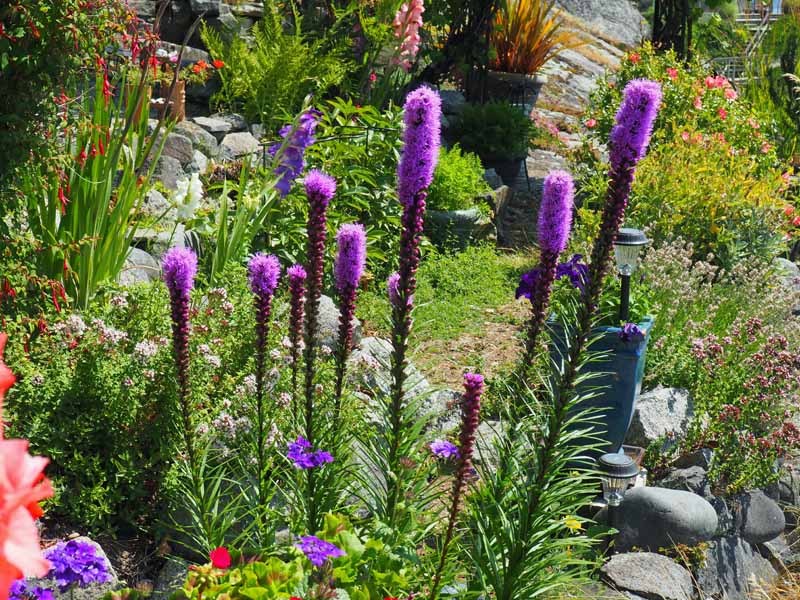
Easy to grow and propagate, it’s a low-maintenance gem that blazes in the dog days of summer while other plants wilt from the heat.
Join us now as we look at how to add this pretty prairie stalwart to your garden!
What You Will Learn
Cultivation and History
Native to the prairies and meadows of Eastern North American, L. spicata is a hardy perennial that produces narrow, grass-like leaves and tall spikes of vibrant purple, bottlebrush flowers.
Blooming from mid-summer to autumn, this clump-forming perennial belongs to the Asteraceae, or aster family, and the Liatris genus is composed of approximately 40 species.
Plants grow from a corm, forming large, tuberous roots that are hardy in Zones 3 to 9. In spring, delicate grassy foliage is followed by sturdy stalks topped with striking, feathery flowers of vibrant purple or white.
Long flower heads are comprised of multiple, mini florets that bloom from top to bottom, and cover about the top third of each flower stalk.
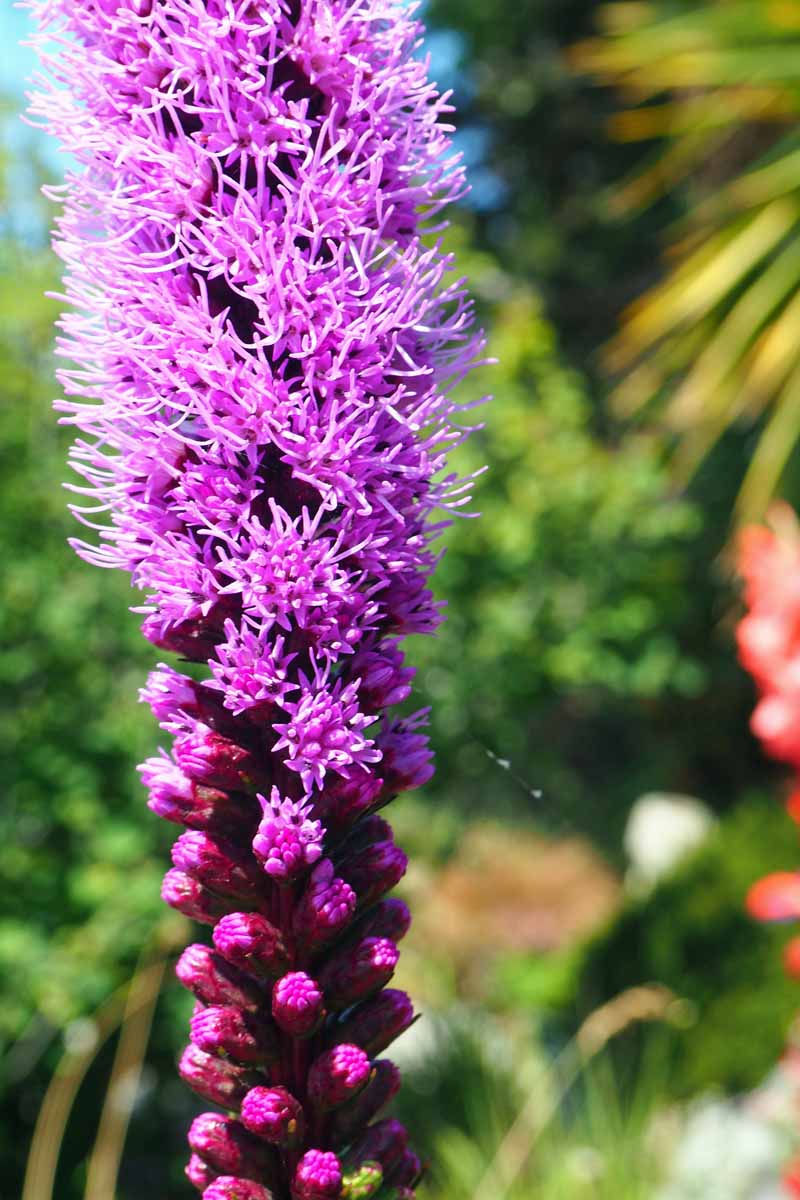
Growth is upright, and a full stand takes up little garden space. Flower stems rarely need staking unless grown in overly moist, rich soil.
The fine textured foliage remains attractive all summer. In the fall, leaves and stalks turn a rich orangey bronze with wheat-colored seed heads.
Larger clumps benefit from division every few years to prevent crowding and dead spots forming in the center.
A favorite of florists, it’s long-lasting as a cut flower and makes an attractive addition to containers, cutting gardens, flower beds, and naturalized or informal plantings.
The distinctive flower spikes grow one to five feet tall and are magnets for numerous pollinators including native bees, butterflies, and hummingbirds. Local and migrating birds will also visit as they enjoy the fruit of fall-ripening seeds.
Roots of L. spicata have long been used by Native Americans for a variety of ailments including the treatment of abdominal pain, colic, snake bite, and swelling.
Propagation
Blazing star can be propagated from division of corms and tuberous roots, and from seed.
By Division
- Dig around the clump when leaves first emerge in spring, then lift out with a spade.
- Gently rinse off the soil to expose the tuberous root mass.
- Using a sharp, clean knife, cut the roots into sections, ensuring each section has roots and a growing bud or leaf.
- Break off any small bulbils, or baby corms.
- Sprinkle cut divisions with a fungicide such as garden sulfur.
- Plant tuberous roots five inches deep in a starburst pattern, spacing new pieces 8-16 inches apart.
- Plant bulbils two to three inches deep and four to eight inches apart.
- Fill in planting hole and water promptly, until the top six inches of soil are moist.
- To keep down weeds and conserve moisture, cover with a thick two- to four-inch layer of dry mulch, such as hay or dry grass clippings.
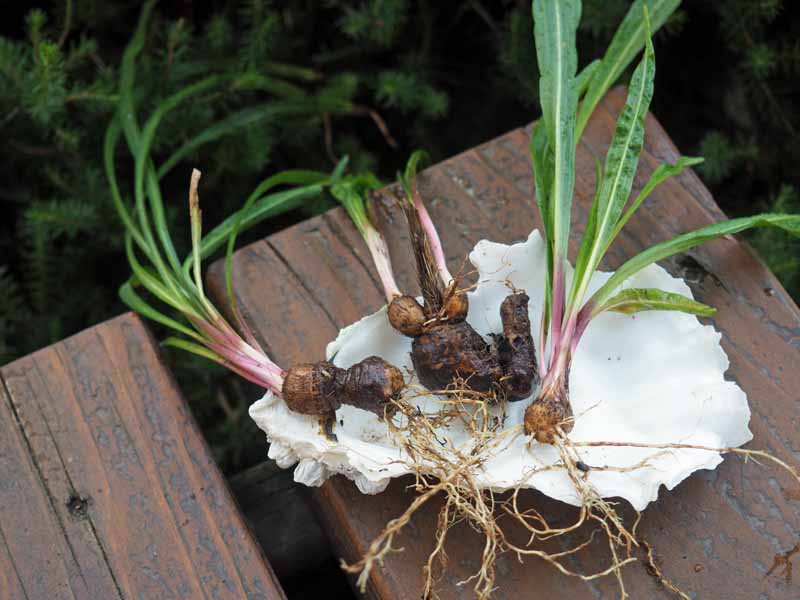
By Seed
L. spicata can also be started from seed.
Seeds are viable for less than 12 months and can be collected in the fall and direct sown into the garden right away – if you have cold winters. They need extensive cold exposure in a moist environment to germinate the following spring.
If you don’t have time to plant in place, sow in flats and leave the flats outdoors over the winter for germination and spring planting.
If your winters are mild, collect seeds in the fall and store in a cool, dry spot. Approximately 12 weeks before direct sowing outdoors, mix seeds with moist vermiculite, peat, or sand in a resealable bag. Store in the refrigerator until you’re ready to plant.
Plant cold-treated seeds outdoors when the weather has warmed to around 65°F.
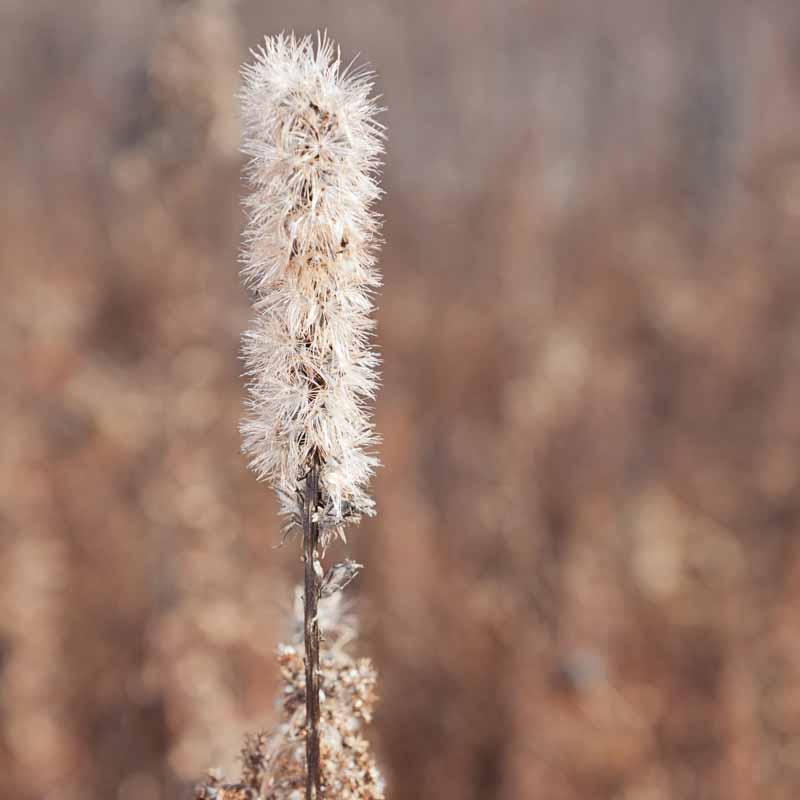
Alternatively, after 12 weeks of cold, pot up seeds into four-inch containers to sprout. Use a potting mix of equal parts moist sand, compost, and vermiculite and lightly spread the seeds on top. Cover with a bare dusting of potting mix.
Place in a cool, bright location, water regularly, and plant seedlings into the garden after the last frost date for your region.
Plants started from seed will bloom in their second year of maturity.
Best Growing Conditions
Like a true prairie belle, cultivation of L. spicata is straightforward.
Most cultivars prefer full sun, or some light shade, and well-drained soil of lean to medium fertility. Good drainage is a must, as soggy conditions can cause root rot.
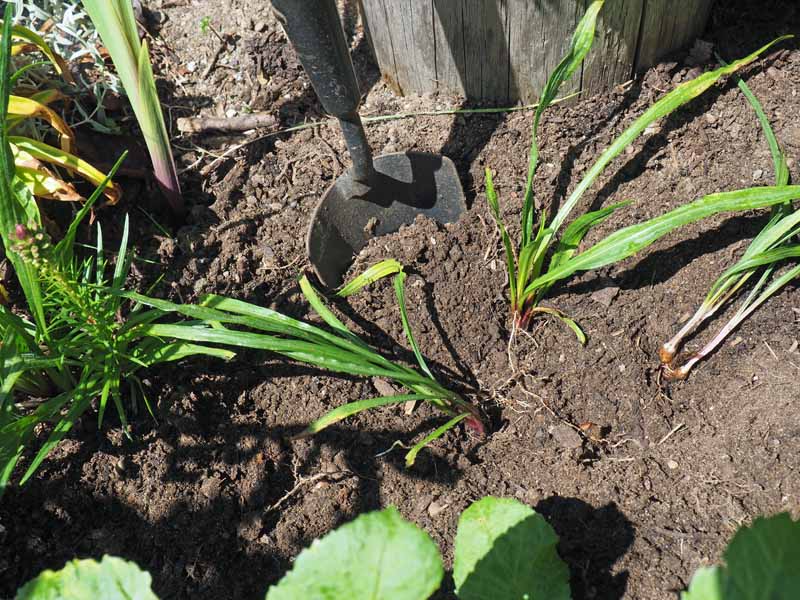
Plant in cool spring weather to allow young plants to get established.
- Prepare the soil by loosening to a depth of eight inches and working in a one to two-inch layer of organic matter, such as aged compost or manure.
- Amend the soil with sand or fine grit to improve drainage if needed.
- Create a planting hole twice as wide and slightly deeper than the root ball . Mix in some bone meal.
- Add the plants, fill in the hole, and firm in place.
- Water to settle and water regularly until established.
Drought tolerance in one of blazing star’s highly desirable traits, as the water-retentive corms and tuberous roots can sustain them through dry periods.
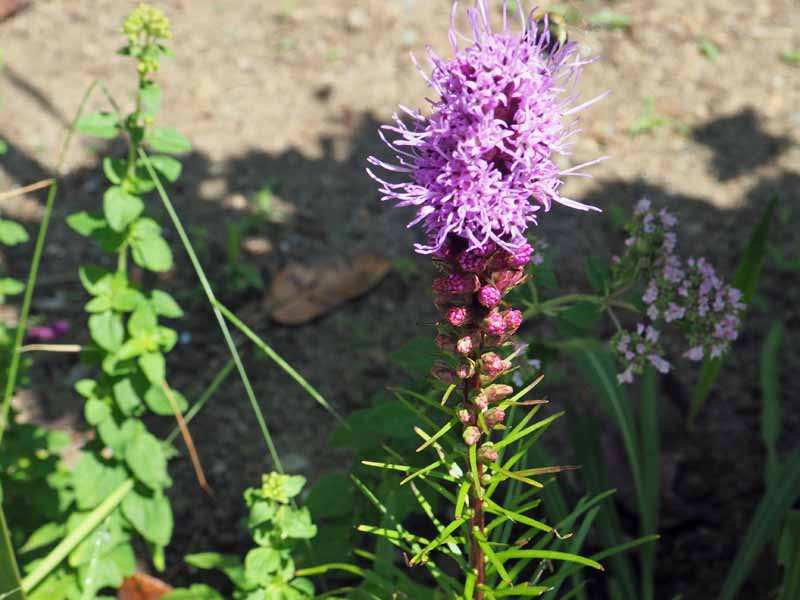
And while they need well-draining soil, they can happily tolerate more moisture than many other perennials, making them suitable for rain gardens as well.
Plants grown from tuberous divisions will bloom in the first year of growth, while those started from bulbils can take two years to flower.
Growing Tips
Blazing star is a tough plant that thrives naturally in a harsh prairie environment. But in dry weather, new plantings should be watered weekly until a strong root system is established.
As with all bulbs and corms, avoid over-watering.
After the first few months, your Liatris will need little attention. Relatively drought tolerant, they’re mostly pest and disease resistant, and deer tend to ignore them as well.
A good choice to attract pollinators, L. spicata is rich in nectar and pollen. Plant some in open areas to broadcast their appeal to flying insects.
Ripe seedheads provide a rich source of food for birds such as goldfinches and migrating songbirds.
Pruning and Maintenance
Foliage and stems can be cleaned up any time after dying and turning shades of bronze, brown, and orange. But they add a nice touch to the fall and winter garden and can be left in place until spring cleanup.
In early spring, remove any vegetative debris and side dress established clumps by working in organic matter such as mature compost, humus, or manure.
Reliable Cultivars to Consider
Only one species, L. spicata, aka blazing star, is easily found in garden centers, but it has several reliable cultivars.
You can find 50-seed packets available at Earthbeat Seeds.
Blazing Stars Mix
Blazing Stars Mix is a blend of densely packed purple and white flower heads, combining white and deep, blue-purple flowers.
Hardy in Zones 3 to 10, this bold combo grows 24 to 36 inches tall and blooms from mid-summer to fall.
Pick up a package of 10 large bulbs online from Burpee.
Floristan Violet
‘Floristan Violet’ offers multiple stalks of amethyst colored plumes that begin blooming in early summer.
Hardy in Zones 3 to 9, this heat and humidity-resistant cultivar shines in the summer garden.
Order bare root plants online from Burpee.
Kobold
‘Kobold’ is a popular choice in a more compact form.
Hardy in Zones 3 to 9, this cultivar grows 18 to 36 inches in height and handles heat and humidity with ease.
Bare root plants can be ordered online from Burpee.
Other Choices
Home Depot also offers an online selection with a 12-pack of Blazing Star Mixed bulbs, combining white and purple flowers. Hardy in Zones 3 to 9, mature plants reach a height of 48 inches.
Seeds of L. aspera ‘Gayfeather’ can also be purchased online, like this 500-gram packet that’s available from True Leaf Market. Sow indoors or out, and flowers will appear in their second year.
Other species, like pinkscale blazing star (L. elegans) and meadow blazing star (L. ligulistylis) may be available for home cultivation through local botanical gardens, specialty mail-order nurseries, and wildflower centers.
Managing Pests and Diseases
Insect problems are rare, but L. spicata are used as food plants by the larvae for several species of flower moths, including the rare glorious flower moth (Schinia gloriosa), and the bleeding flower moth (S. sanguinea).
Both of these feed exclusively on plants from the Liatris genus.
Infestations are not usually problematic, and larvae can be hand-picked or blasted off with a strong spray from the hose.
Blazing star can be subject to some fungal diseases, including leaf spot and powdery mildew.
Remove any infected foliage, reduce watering, and allow the top two inches of soil to dry out. Divide and respace if necessary.
Adequate spacing of plants allows sufficient sunlight and air circulation, which helps keep fungi problems to a minimum.
Best Uses in the Garden
Liatris makes a tall, eye-catching statement in flower beds, containers, cutting gardens, and naturalized settings.
A valuable addition to perennial gardens, these plants provide a reliable vertical contrast to mounded or broad-leaved plants like hostas and are equally at home in the meadow or naturalized areas.
The purple flowers contrast nicely with any orange or yellow-flowered plants such as black-eyed susans (Rudbeckia hirta), coreopsis, daylilies (Hemerocallis), or marigolds (Tagetes).
Or for a bold sweep of color, mix with other purples and vibrant reds from plants like Gladiolus, Osteospermum, Pelargonium, and Verbena.
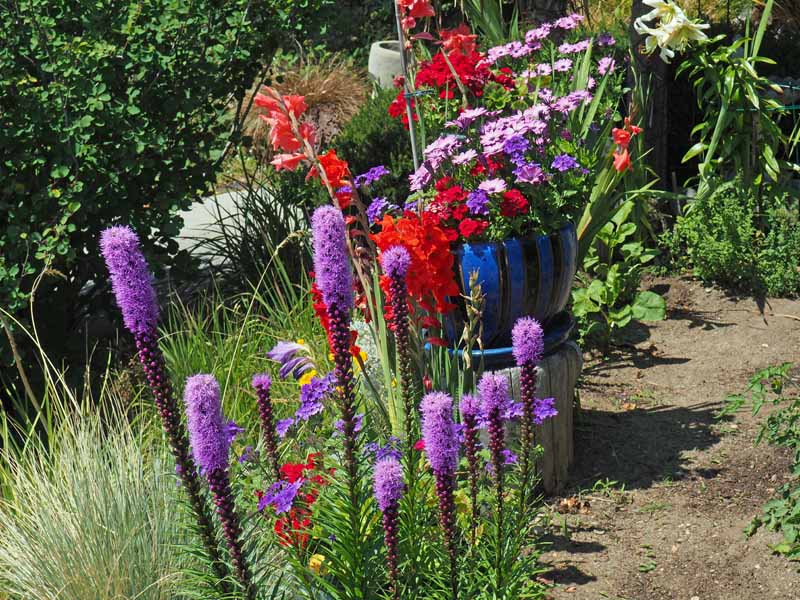
The elegant, wand-like flowers bloom in shades of amethyst, pink, or white. Stunning and long-lasting in summer flower arrangements, they’re a must-have in the cutting garden.
L. spicata also has the presence to stand alone as a specimen plant and is particularly effective in large stands and drifts. And as an indigenous species, blazing star is robust enough to hold its own when planted in meadows or naturalized settings with other wildflowers.
Rich in nectar and pollen, the flowers attract a wide range of butterflies, making them right at home in the butterfly garden.
They make a handsome companion for ornamental grasses and sedges. And in casual gardens, they mix well with other summer favorites like butterfly weed (Asclepias tuberosa), blanket flower (Gaillardia), and coneflower (Echinacea).
Dried liatris makes an attractive addition to dried flower arrangements as well.
To dry, harvest the stalks when about 1/2 to 2/3 of the flowers are blooming. Hang upside down in a cool, dry location for three to four weeks. Or use a flower desiccant like silica gel to dry and preserve.
Liatris Quick Reference Growing Chart
| Plant Type: | Perennial, flowering herbaceous plant | Flower Color: | Purple, lavender, pink, white |
| Native to: | North America | Tolerance: | Drought, poor and/or clay soils |
| Hardiness (USDA Zone): | 3-9 | Maintenance: | Minimal |
| Bloom Time: | July-August | Soil Type: | Various |
| Exposure: | Full sun | Soil pH: | Acidic to alkaline, 5.6-7.5 |
| Time to Maturity: | 2 years when started from seed | Soil Drainage: | Well-draining |
| Spacing: | 15 inches, may vary by cultivar | Companion Planting: | Black-eyed susans, coreopsis, daylilies, marigolds, verbena |
| Planting Depth: | 1/4 inch (seeds) | Uses: | Centerpiece, mass plantings, cutting, dried arrangements |
| Height: | 2-4 feet, varies by cultivar | Attracts: | Birds, butterflies, bees |
| Spread: | 15-18 inches | Family: | Asteraceae |
| Water Needs: | Low to moderate | Genus: | Liatris |
| Pests & Diseases: | Glorious flower moth, bleeding flower moth, leaf spot, powdery mildew | Species: | spicata |
Pride of the Prairies
Now that you know about the stellar properties of this pride of the prairies, do you think you might add a stand of blazing star to your garden?
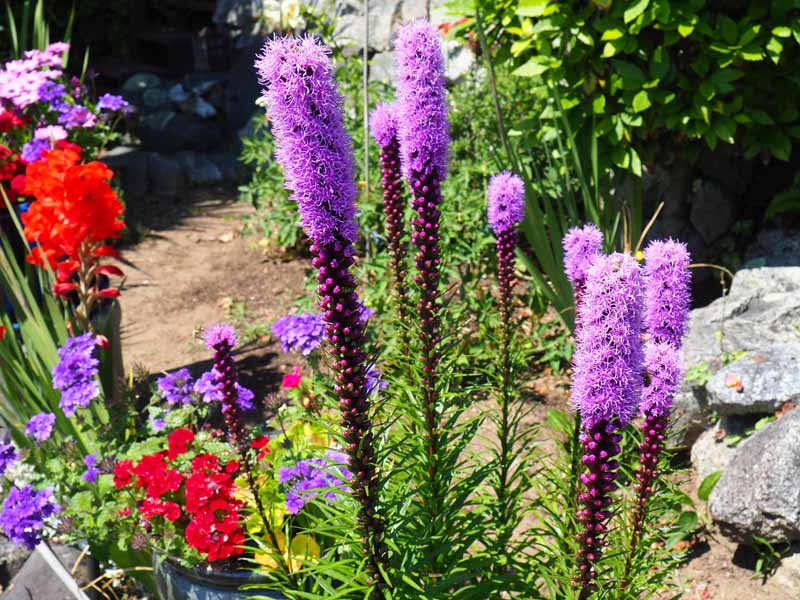
If you have any questions about growing this pretty wildflower, drop us a line in the comments below.
And be sure to check our articles on other indigenous North American perennials that thrive in hot summer conditions.
All of these plants are winners with their easy-to-care-for habits and long-lasting color!
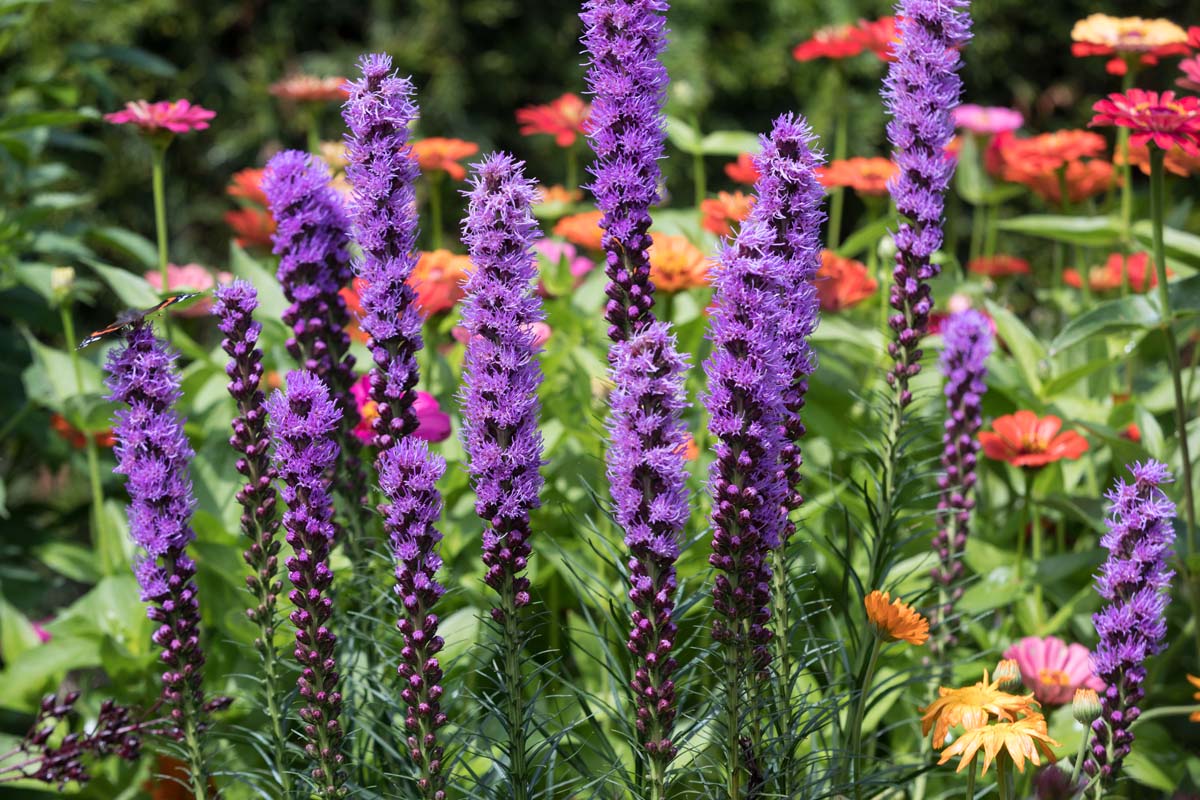

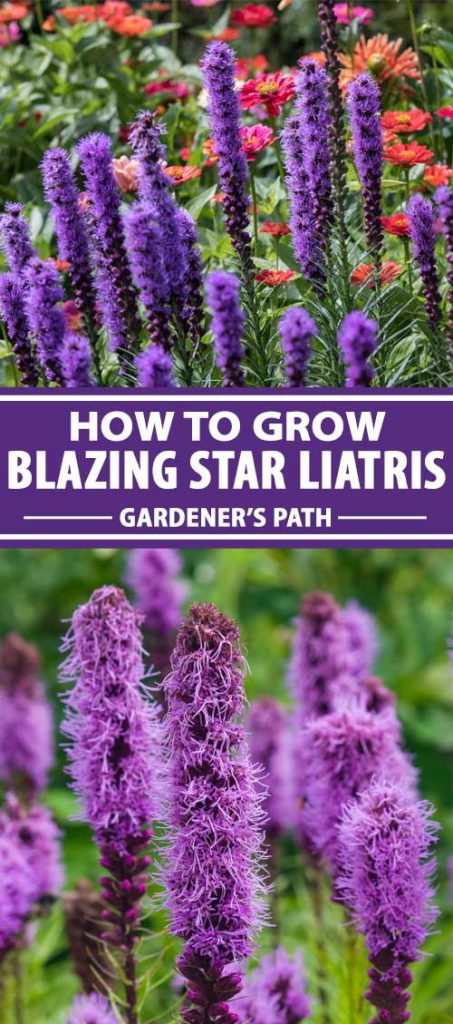
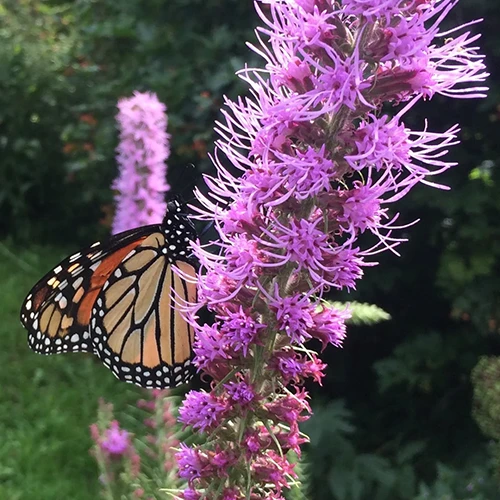
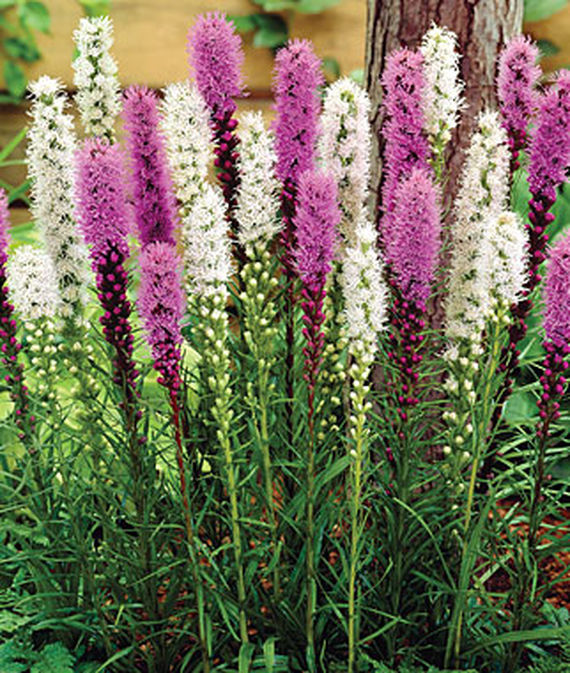
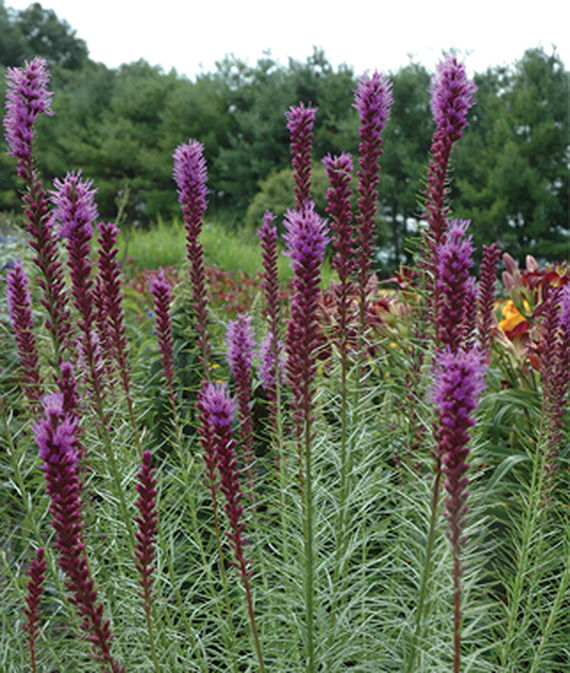

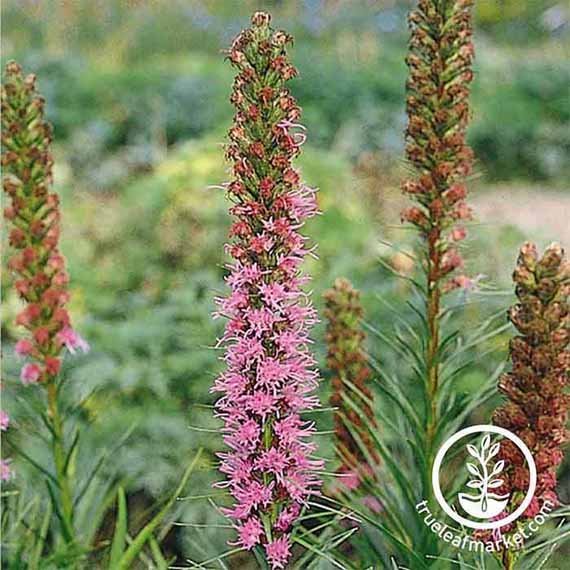
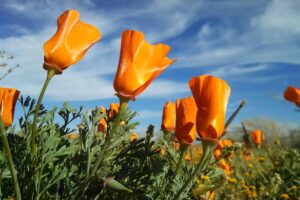
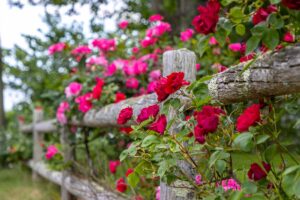
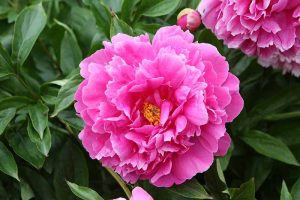
I purchased Blazing Star in full bloom in May in Florida. Should it be deadheaded?
Hi Karen, you can deadhead liatris when they’ve finished blooming, or you can leave the flower stalks in place.
The flowers and stalks dry out to attractive shades of copper and brown and can be left until late fall if desired, and songbirds the enjoy the seeds as they ripen.
But, if these are first year plants, I’d recommended deadheading to divert energy into the corms for a bigger, better display next year – but don’t cut away the leaves, allow them to age and dry out on their own.
Thanks for asking!
Can I plant liatris in an ajuga bed? Ajuga blooms early and liatris late but I didn’t know if one would smother the other.
That sounds like a nice combo Pam, but I’m concerned about the ajuga taking over the bed – it spreads much faster than liatris.
But, you could try a landscape root barrier around the patches of blazing star.
Sink it into the soil at the edges of the plant’s drip line and this might be enough to keep the ajuga at bay.
Thanks for your question, and let us know how it works out for you!
I live in a place with frigid winters (Alberta, Canada). Can I grow these in wooden planter boxes? And should I take the box inside every winter? I am assuming that these are perennial plants normally if grown in the ground itself.
Hey Sbc, yes, they will grow in adequately sized planters.
And they’re hardy to Zone 3, so bringing them indoors may not be necessary.
If you’re south of the Grande Prairie/Stave Lake region, you should be okay leaving them outdoors (with a nice thick mulch). But if you’re in colder regions further north, treat them as annuals and bring your planters in for winter cold protection.
Thanks for asking!
Wow Lorna, great article. I am about to attempt my first ‘division’ lol. Thanks for the great info and pictures, esp. the advice re companion plantings.
I was given a bag of 40 Liatris Blazing Star (it is late June). Can I plant them now?
Wow, great score Kitty!
If the corms are planted now, in late June, you may get some leafy growth but it will be too late for flowers to form this year and they may struggle to get established in summer’s heat.
I’d recommend holding off on planting them until the end of summer or early fall.
Until then, you can keep the corms in a bin or basket of slightly moist sphagnum or peat moss and store them in a cool, dark location until planting.
Good luck, and thanks for your question!
I planted blazing star and it is growing great. Though I noticed that a flower spike appeared and it drooped a little bit and then straightened up again. I wanted to know why did that happen? And secondly, how long does a flower spike take to fully bloom? It has been 2 weeks since the spike appeared yet there are no flowers. Thanks.
Hey Fatima, I can think of two reason for the drooping. Although they’re drought resistant plants once established, new plants require regular watering to ensure healthy growth. It could be the roots dried out too much and recovered with moisture, causing the stalk to droop then straighten. Or, it could be too much nitrogen in the soil – which creates lush foliage, but can also create soft flower stalks. They require lean, well-draining soil with a lightly gritty texture. A side dressing of compost worked into the soil in spring satisfies their nutrient requirements. Rich soils and… Read more »
Hello, have started a blazing star in a planter, happy to say I have a bud coming. My question is, I want to transplant the blazing star to my garden as the pot is only a medium size. Should I wait till the first bud blooms or is it okay to transplant in the garden as the bud is just starting, with no color showing as of yet?
Hi Mary, you can transplant to the garden with a small bud if needed, but avoid doing so in a heat wave.
Ensure the planting hole is well-watered and enriched with organic matter such as compost, and mix in a little bone meal to help form strong roots. Wait until late afternoon or early evening to plant out, after the sun is away from your chosen site.
Water regularly until the roots are well-established at summer’s end, and feed once after transplanting with a balanced, water-soluble fertilizer.
Good luck!
Thanks for this informative article. I have a couple of these in my garden and was not sure what they are. Very pretty though. I would like to get more now that I know more about them.
We have just started a pollinator garden and planted our first blazing stars a month ago. They had beautiful purple blossoms, but they didn’t last very long at all. I cut the stem with the dead blooms off just below the bottom blossoms. Was I supposed to only remove the blossoms themselves?
You got it right Sheila. Once the flowers have finished, cut the flower stem as low as possible without removing any leaves.
And your plants will bloom longer, with larger flower spikes, after they settle in to their new home… in a couple of years, you’ll have some beautiful clumps with a long-lasting display.
Thanks for asking!
Hi Lorna, I would love to grow these beautiful plants, but I live in Houston, Texas and is very hot and humid in the summertime. I’m just not sure how well they would do in my area. Also, do you think it’s better to plant from seed or baby plants? I will appreciate your advice.
Thanks,
Lucy
Oh, you’re in luck Lucy, because there’s a native variety that loves the heat and humidity of Texas, Oklahoma, and the southern Great Plains region! Texas Blazing Star, Liatris mucronata, is wonderfully showy with large plumes of mauve-pink flowers that butterflies love. It’s also tough and resilient, and a good choice for drier areas and xeriscaping. It’s easily grown from either corms or baby plants, but young plants have the advantage of a head start on growth – so you’ll see flowers a bit earlier. Wait until cooler fall temperatures to plant out, and water regularly until they’re well established… Read more »
I have some of these seeds. Can I plant them now in pots to sell? Will they be able to be transplanted now?
Hey Joyce, these seeds need to go through a cold period in order to germinate.
If you have cold winters, they can be direct sown into pots in autumn and left outdoors over winter. If not, you’ll have to stratify seeds in a refrigerator before potting – the steps are outlined in the Seed Propagation section above.
Seedlings can be transplanted out the following spring, but plants won’t produce flowers for two years.
Good luck!